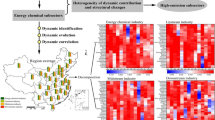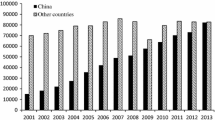Abstract
The nonferrous metal industry (NMI) of China consumes large amounts of energy and associated emissions of carbon dioxide (CO 2) are very high. Actions to reduce CO 2 emissions and energy consumption are warranted. This study aims to analyze current China NMI trends of CO 2 emissions and energy consumption including the underlying regional driver characteristics. We analyze the changes of CO 2 emissions in the NMI based on the Logarithmic Mean Divisia Index (LMDI) method from 2000 to 2011. Then, a classification system is used to study the regional differences in emission changes from the NMI. The results show that the emissions of the Chinese NMI increased rapidly at an average annual growth rate of 31 million metric tons. The economic scale and energy intensity are the main driving factors responsible for the change in the emissions, while carbon emission coefficients make only a small contribution toward decreasing the emissions, and the energy structure has a volatile effect. Emissions and energy intensity of 29 China provinces were divided into five categories. The change in the trend of each region is indicated in this paper. Hebei is one of the provinces that achieved the best performance, and Chongqing achieved the worst performance among all of the regions. The analysis suggests that the main emphasis of CO 2 emission mitigation should be focused on controlling the economic scale and improving the energy intensity. Developing the use of clean energy technologies and policies in both the NMI and power industries is important.




Similar content being viewed by others
References
Akbostancı E, Tunç Gİ, Türüt-Aşık S (2011) CO 2 emissions of Turkish manufacturing industry: a decomposition analysis. Appl Energy 88(6):2273–2278
Ang BW (2004) Decomposition analysis for policymaking in energy: which is the preferred method. Energy Policy 32(9):1131–1139
Ang BW, Choi KH (1997) Decomposition of aggregate energy and gas emission intensities for industry: a refined Divisia index method. Energy J 18(3):59–73
Ang BW, Liu N (2007) Handling zero values in the logarithmic mean Divisia index decomposition approach. Energy Policy 35(1):238–246
Baležentis A, Baležentis T, Streimikiene D (2011) The energy intensity in Lithuania during 1995–2009: a LMDI approach. Energy Policy 39(11):7322–7334
Boyd G, McDonald JF, Ross M, Hanson DA (1987) Separating the changing composition of US manufacturing production from energy efficiency improvements: a Divisia index approach. Energy J 8(2):77–96
Bureau CS (2011) China statistical yearbook. China Statistical Bureau, Beijing
Fernández González P, Landajo M, Presno MJ (2014) The driving forces behind changes in CO2 emission levels in EU-27. Differences between member states. Environ Sci Pol 38:11–16
González D, Martínez M (2012) Changes in CO2 emission intensities in the Mexican industry. Energy Policy 51:149–163
Hammond GP, Norman JB (2012) Decomposition analysis of energy-related carbon emissions from UK manufacturing. Energy 41(1):220–227
IEA (2011) World energy outlook 2011. OECD/IEA, Paris
Kang J, Zhao T, Ren X, Lin T (2012) Using decomposition analysis to evaluate the performance of China’s 30 provinces in CO 2 emission reductions over 2005–2009. Nat Hazards 64(2):999–1013
Lee K, Oh W (2006) Analysis of CO 2 emissions in APEC countries: a time-series and a cross-sectional decomposition using the log mean Divisia method. Energy Policy 34(17):2779–2787
Lin B, Moubarak M (2013) Decomposition analysis: Change of carbon dioxide emissions in the Chinese textile industry. Renew Sustain Energy Rev 26:389–396
O’Mahony T, Zhou P, Sweeney J (2012) The driving forces of change in energy-related CO2 emissions in Ireland: a multi-sectoral decomposition from 1990 to 2007. Energy Policy 44:256–267
Oh I, Wehrmeyer W, Mulugetta Y (2010) Decomposition analysis and mitigation strategies of CO 2 emissions from energy consumption in South Korea. Energy Policy 38(1):364–377
Ren S, Hu Z (2012) Effects of decoupling of carbon dioxide emission by Chinese nonferrous metals industry. Energy Policy 43:407–414
Ren S, Fu X, Chen X (2012) Regional variation of energy-related industrial CO 2 emissions mitigation in China. China Econ Rev 23(4):1134–1145
Tian Y, Zhu Q, Geng Y (2013) An analysis of energy-related greenhouse gas emissions in the Chinese iron and steel industry. Energy Policy 56:352–361
Wang C, Chen J, Zou J (2005) Decomposition of energy-related CO 2 emission in China: 1957–2000. Energy 30(1):73–83
Xu JH, Fleiter T, Eichhammer W, Fan Y (2012) Energy consumption and CO 2 emissions in China’s cement industry: a perspective from LMDI decomposition analysis. Energy Policy 50:821–832
Acknowledgments
This study was funded by the National Natural Science Foundation of China (71373172).
Author information
Authors and Affiliations
Corresponding author
Rights and permissions
About this article
Cite this article
Shi, Y., Zhao, T. A decomposition analysis of carbon dioxide emissions in the Chinese nonferrous metal industry. Mitig Adapt Strateg Glob Change 21, 823–838 (2016). https://doi.org/10.1007/s11027-014-9624-x
Received:
Accepted:
Published:
Issue Date:
DOI: https://doi.org/10.1007/s11027-014-9624-x




